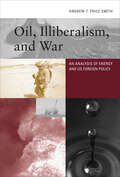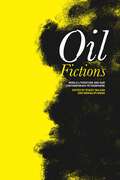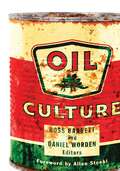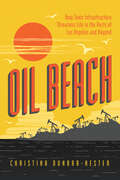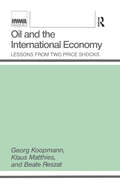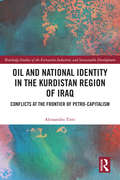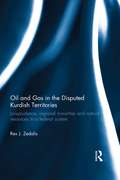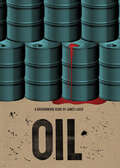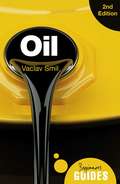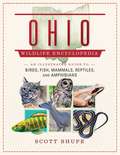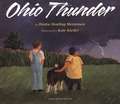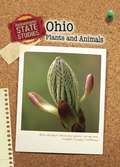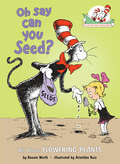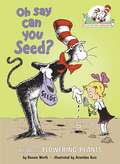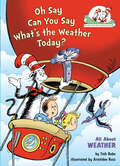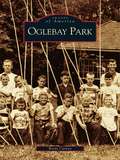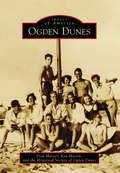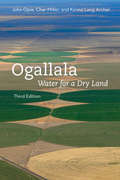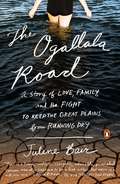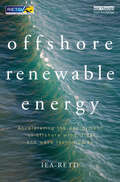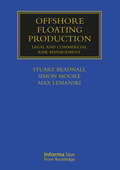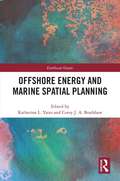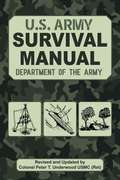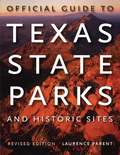- Table View
- List View
Oil, Illiberalism, and War: An Analysis of Energy and US Foreign Policy (The\mit Press Ser.)
by Andrew T. Price-SmithAn argument that America's addiction to crude oil has driven a foreign policy of intervention and exploitation hidden behind a facade of liberal internationalism.The United States is addicted to crude oil. In this book, Andrew Price-Smith argues that this addiction has distorted the conduct of American foreign policy in profound and malign ways, resulting in interventionism, exploitation, and other illiberal behaviors that hide behind a facade of liberal internationalism. The symbiotic relationship between the state and the oil industry has produced deviations from rational foreign energy policy, including interventions in Iraq and elsewhere that have been (at the very least) counterproductive or (at worst) completely antithetical to national interests.Liberal internationalism casts the United States as a benign hegemon, guaranteeing security to its allies during the Cold War and helping to establish collaborative international institutions. Price-Smith argues for a reformulation of liberal internationalism (which he terms shadow liberalism) that takes into account the dark side of American foreign policy. Price-Smith contends that the “free market” in international oil is largely a myth, rendered problematic by energy statism and the rise of national oil companies. He illustrates the destabilizing effect of oil in the Persian Gulf, and describes the United States' grand energy strategy, particularly in the Persian Gulf, as illiberal at its core, focused on the projection of power and on periodic bouts of violence. Washington's perennial oscillation between liberal phases of institution building and provision of public goods and illiberal bellicosity, Price-Smith argues, represents the shadow liberalism that is at the core of US foreign policy.
Oil Fictions: World Literature and Our Contemporary Petrosphere (AnthropoScene)
by Stacey Balkan and Swaralipi NandiOil, like other fossil fuels, permeates every aspect of human existence. Yet it has been largely ignored by cultural critics, especially in the context of the Global South. Seeking to make visible not only the pervasiveness of oil in society and culture but also its power, Oil Fictions stages a critical intervention that aligns with the broader goals of the energy humanities.Exploring literature and film about petroleum as a genre of world literature, Oil Fictions focuses on the ubiquity of oil as well as the cultural response to petroleum in postcolonial states. The chapters engage with African, South American, South Asian, Iranian, and transnational petrofictions and cover topics such as the relationship of colonialism to the fossil fuel economy, issues of gender in the Thermocene epoch, and discussions of migration, precarious labor, and the petro-diaspora. This unique exploration includes testimonies of the oil encounter—through memoirs, journals, and interviews—from a diverse geopolitical grid, ranging from the Permian Basin to the Persian Gulf.By engaging with non-Western literary responses to petroleum in a concentrated, sustained way, this pathbreaking book illuminates the transnational dimensions of the discourse on oil. It will appeal to scholars and students working in literature and science studies, energy humanities, ecocriticism, petrocriticism, environmental humanities, and Anthropocene studies.In addition to the editors, the contributors to this volume include Henry Obi Ajumeze, Rebecca Babcock, Ashley Dawson, Sharae Deckard, Scott DeVries, Kristen Figgins, Amitav Ghosh, Corbin Hiday, Helen Kapstein, Micheal Angelo Rumore, Simon Ryle, Sheena Stief, Imre Szeman, Maya Vinai, and Wendy W. Walters.
Oil Culture
by Daniel Worden Ross BarrettIn the 150 years since the birth of the petroleum industry oil has saturated our culture, fueling our cars and wars, our economy and policies. But just as thoroughly, culture saturates oil. So what exactly is "oil culture"? This book pursues an answer through petrocapitalism's history in literature, film, fine art, wartime propaganda, and museum displays. Investigating cultural discourses that have taken shape around oil, these essays compose the first sustained attempt to understand how petroleum has suffused the Western imagination.The contributors to this volume examine the oil culture nexus, beginning with the whale oil culture it replaced and analyzing literature and films such as Giant, Sundown, Bernardo Bertolucci's La Via del Petrolio, and Ben Okri's "What the Tapster Saw"; corporate art, museum installations, and contemporary photography; and in apocalyptic visions of environmental disaster and science fiction. By considering oil as both a natural resource and a trope, the authors show how oil's dominance is part of culture rather than an economic or physical necessity. Oil Culture sees beyond oil capitalism to alternative modes of energy production and consumption.Contributors: Georgiana Banita, U of Bamberg; Frederick Buell, Queens College; Gerry Canavan, Marquette U; Melanie Doherty, Wesleyan College; Sarah Frohardt-Lane, Ripon College, Matthew T. Huber, Syracuse U; Dolly Jørgensen, Umeå U; Stephanie LeMenager, U of Oregon; Hanna Musiol, Northeastern U; Chad H. Parker, U of Louisiana at Lafayette; Ruth Salvaggio, U of North Carolina, Chapel Hill; Heidi Scott, Florida International U; Imre Szeman, U of Alberta; Michael Watts, U of California, Berkeley; Jennifer Wenzel, Columbia University; Sheena Wilson, U of Alberta; Rochelle Raineri Zuck, U of Minnesota Duluth; Catherine Zuromskis, U of New Mexico.
Oil Beach: How Toxic Infrastructure Threatens Life in the Ports of Los Angeles and Beyond
by Christina Dunbar-HesterCan the stories of bananas, whales, sea birds, and otters teach us to reconsider the seaport as a place of ecological violence, tied to oil, capital, and trade? San Pedro Bay, which contains the contiguous Ports of Los Angeles and Long Beach, is a significant site for petroleum shipping and refining as well as one of the largest container shipping ports in the world—some forty percent of containerized imports to the United States pass through this so-called America’s Port. It is also ecologically rich. Built atop a land- and waterscape of vital importance to wildlife, the heavily industrialized Los Angeles Harbor contains estuarial wetlands, the LA River mouth, and a marine ecology where colder and warmer Pacific Ocean waters meet. In this compelling interdisciplinary investigation, award-winning author Christina Dunbar-Hester explores the complex relationships among commerce, empire, environment, and the nonhuman life forms of San Pedro Bay over the last fifty years—a period coinciding with the era of modern environmental regulation in the United States. The LA port complex is not simply a local site, Dunbar-Hester argues, but a node in a network that enables the continued expansion of capitalism, propelling trade as it drives the extraction of natural resources, labor violations, pollution, and other harms. Focusing specifically on cetaceans, bananas, sea birds, and otters whose lives are intertwined with the vitality of the port complex itself, Oil Beach reveals how logistics infrastructure threatens ecologies as it circulates goods and capital—and helps us to consider a future where the accumulation of life and the accumulation of capital are not in violent tension.
Oil and the International Economy
by Georg Koopmann Klaus Matthies Beate ReszatThe oil price increases of the 1970s left deep marks on the world economy. They led to a massive redistribution of income in favor of oil-producing countries, and caused serious disruption of growth, imbalances in foreign trade, and problems of stability in oil-importing countries. Despite the present levelling off, the authors suggest that more price increases remain a distinct possibility.Oil and the International Economy examines the effects of rising oil prices on the international financial system and identifies ways that oil-importing countries can overcome the financial and adjustment problems caused by them. The authors project the long-term trend in real oil prices and present economic policy options to help avoid future financial problems for industrialized and developing nations alike.
Oil and National Identity in the Kurdistan Region of Iraq: Conflicts at the Frontier of Petro-Capitalism (Routledge Studies of the Extractive Industries and Sustainable Development)
by Alessandro TintiExamining the interplay between the oil economy and identity politics using the Kurdistan Region of Iraq as a case study, this book tells the untold story of how extractivism in the Kurdish autonomous region is interwoven in a mosaic of territorial disputes, simmering ethnic tensions, dynastic rule, party allegiances, crony patronage, and divergent visions about nature. Since the ousting of Saddam Hussein, the de-facto borders of the Kurdistan Region of Iraq have repeatedly changed, with energy interests playing a major role in such processes of territorialisation. However, relatively little research exists on the topic. This book provides a timely, empirical analysis of the intersections between extractive industries, oil imaginaries, and identity formation in one of the most coveted energy frontiers worldwide. It shines a light on relations between the global production networks of petro-capitalism and extractive localities. Besides the strained federal relationship with the Iraqi central government, the transformative effects the petroleum industry has had on Kurdish society are also explored in depth. Moreover, the book fills a gap in the literature on Kurdish Studies, which has devoted scant attention to energy-related issues in the re-imagination of Kurdish self-determination. This book will be of great interest to students and scholars of the extractive industries, energy studies, conflict studies, Middle Eastern politics, and political ecology.
Oil and Gas in the Disputed Kurdish Territories: Jurisprudence, Regional Minorities and Natural Resources in a Federal System
by Rex J. ZedalisThis book examines the historical and contextual background to the oil and gas resources in the Kurdish territories, placing particular emphasis on the reserves situated in the disputed provinces. The volume is singularly unique in focusing on an examination of the rules reflected in both the national and the regional constitutional, legislative, and contractual measures and documents relevant to the question of whether the central government in Baghdad or the Kurdish Regional Government (KRG) in Erbil has a stronger claim to legal control over the oil and gas resources in the disputed Kurdish territories. As a subsidiary focus, the author also draws attention to how the basic thrust of the volume connects to broader jurisprudential issues regarding the nature and purpose of law, the matter of claims by native peoples to natural resources on traditional lands, and the place of regional minorities operating in a federal system. Since the law examined is domestic or municipal in origin, additional reference is made to the role that such law can play in the "bottom up" (as opposed to more conventional "top down") development of international law. The book’s opening chapters provide a valuable contextual introduction, followed by a number of substantive chapters providing an analytical and critical assessment of the controlling legal rules. Written in a scholarly, yet accessible style, and covering matters of basic importance to academics, lawyers, political scientists, government representatives, and students of energy and natural resources, as well as those of developing legal structures, Oil and Gas in the Disputed Kurdish Territories is an essential addition to any collection.
Oil: A Groundwork Guide (Groundwork Guides)
by James LaxerThis book explores today’s global dependency on oil and reveals the sobering realities of the relationship between oil, politics and money. An excellent introduction for young adults.Oil, our main source of energy, underlies the world's economy. In the twentieth century its availability and relatively low price allowed for the industrial growth and development of the world's leading economies. The new rapidly developing giants, India and China, want access to the same possibilities. But today we know that cheap, easily accessible oil supplies are dwindling, and we are beginning to recognize the true cost to the world's environment of our profligate use of this form of energy.As Oil shows, a substantial portion of the world's remaining supply lies in countries whose interests are not identical with those of the major industrial powers."[The Groundwork Guides] are excellent books, mandatory for school libraries and the increasing body of young people prepared to take ownership of the situations and problems previous generations have left them." -- Globe and Mail
Oil: A Beginner's Guide (Beginner's Guides)
by Vaclav SmilWorld acclaimed scientist Vaclav Smil reveals everything there is to know about nature's most sought-after resourceOil is the lifeblood of the modern world. Without it, there would be no planes, no plastic, no exotic produce, and a global political landscape few would recognise. Humanity&’s dependence upon oil looks set to continue for decades to come, but what is it? Fully updated and packed with fascinating facts to fuel dinner party debate, Professor Vaclav Smil's Oil: A Beginner's Guide explains all matters related to the &‘black stuff&’, from its discovery in the earth right through to the controversy that surrounds it today.
The Ohio Wildlife Encyclopedia: An Illustrated Guide to Birds, Fish, Mammals, Reptiles, and Amphibians
by Scott ShupeOhio’s wildlife has always played an important role in the history of human beings inhabiting the state. Native Americans depended on birds, mammals, and fish for sustenance and the state’s first Europeans came in search of Beaver and buckskins. Although the state’s wildlife is still an important resource for human consumption, wildlife is also increasingly important in today’s culture for its intrinsic, aesthetic value. For many Ohioans, the age-old traditions of hunting and fishing have been replaced by a desire to simply observe wildlife and experience nature. But most Ohioans are largely unaware of the diversity of species inhabiting their state. This volume is intended to provide an introduction to the state’s fishes, amphibians, reptiles, birds, and mammals.In The Ohio Wildlife Encyclopedia, nationally known naturalist Scott Shupe has collected information on all the wildlife that reside in the Buckeye State. The first in a series of state wildlife encyclopedias, this book will be a handy, usable, layman’s guide to Ohio’s wildlife.Included are over 800 color photographs, depicting the different species of mammals, reptiles, amphibians, birds, and fish, while also offering over 600 range maps to show their territory. Along with basic information for the biology of each animal, Shupe includes the size, habitat, and abundance of each species located in the state.Whether you’re a lover of the outdoors, photography, or are looking to learn more about your state, this comprehensive guide will teach you about the wonderful wildlife that covers the water, earth, and skies of Ohio.
Ohio Thunder
by Denise Dowling Mortensen Kate KieslerZAP! One hundred million volts. Cloud to ground advancing bolts. Lyrical verse and stunning illustrations vividly bring to life the speed and drama of a summer storm on a midwestern farm. Gorgeous paintings depict blackened skies above vast stretches of farmland, long tracts of tall corn, and brightly colored barns, but also add subtext to the story, showing two farm boys and their father reacting to the sudden shift in the weather. This remarkable pairing of word and pictures conveys a sense of wonder about the natural world and makes for a picture book any child who has ever been frightened by a storm will respond to.
Ohio Plants and Animals (Heinemann State Studies)
by Marcia SchonbergWhere is Ohio can you find 300-year-old oak trees? Which pesticide has endangered the bald eagle in Ohio? What kinds of animals live in Ohio's cities? This books contains all kinds of fun and fascinating facts about the plants and animals of Ohio and the habitats in which they live. You'll find information about where and how Ohio plants and animals live, and how these living things fit into the ecosystem. Plus, you'll find out what actions are being taken to protect Ohio's natural environment.
Oh Say Can You Seed?: All About Flowering Plants (Cat in the Hat's Learning Library)
by Bonnie WorthGet ready to bloom and learn all about flowers and plants with the Cat in the Hat--a perfect gift for aspiring gardeners on Earth Day and every day! The Cat in the Hat's Learning Library is a nonfiction picture book series that introduces beginning readers ages 5-8 to important basic concepts. An easy and fun introduction to plant biology! With the able assistance of Thing 1 and Thing 2 - the Cat in the Hat explores the world of plants. Kids will learn about the various parts of plants, seeds, and flowers; basic photosynthesis and pollination; and seed dispersal. Featuring beloved characters from Dr. Seuss's The Cat in the Hat, the Learning Library are unjacketed hardcover picture books that explore a range of nonfiction topics about the world we live in and include an index, glossary, and suggestions for further reading.
Oh Say Can You Seed?: All About Flowering Plants
by Bonnie WorthWith the able assistance of Thing 1 and Thing 2 -- and a fleet of Rube Goldbergian vehicles -- the Cat in the Hat examines the various parts of plants, seeds, and flowers; basic photosynthesis and pollination; and seed dispersal.
Oh Say Can You Say What's the Weather Today?: All About Weather (Cat in the Hat's Learning Library)
by Tish RabeThe Cat and company travel by hot air balloon up and into various weather phenomena including rain, snow, thunder, tornadoes, and (yikes!) even hurricanes! Along the way they learn about thermometers, anemometers, wind vanes, cloud formations, humidity, fog, smog, weather folklore, and how to stay safe in lightning. Written and illustrated in Seussian style, this a great addition to the Cat in the Hat’s Learning Library!
Oglebay Park
by Brent CarneyIn 1926, Earl Oglebay willed his summer estate, Waddington Farm, to the city of Wheeling with the hope that it would provide entertainment and education to the community. He and naturalist A.B. Brooks, both mavericks in ecology and agricultural training, established the unique environmental emphasis still evident in the park's nature center, trails, Discovery Lab, and zoo. The 1,650-acre municipal park nestled in the Wheeling hills also features Wilson Lodge, the premier hotel in the area, and 49 log cabins that pay tribute to the community's storied frontier past. The cabins and the Pine Room Pool were built in the 1930s by the Civilian Conservation Corps. Those brave young men, along with a famous golf course architect, Bob Biery, created the Oglebay Caddy Camp, which has been featured in several major golf magazines. Today, Oglebay Park hosts festivals, legendary jazz bands, and top-notch equestrian events. The park's Winter Festival of Lights is considered to be the nation's largest light show.
Ogden Dunes
by Dick Meister Historical Society of Ogden Dunes Ken MartinOgden Dunes, incorporated in 1925, is the largest and most residential of the three Porter County lake-front communities established in the 1920s. Although it began as a highly restricted resort community with the largest man-made ski jump in North America, it became a middle-class residential community after 1945. Because of its proximity to Gary and Chicago, Ogden Dunes was also a battleground between the forces that wished to conserve the dunes and those that pushed for industrializing them. Alice Gray, Diana of the Dunes; Dorothy Buell, who led the fight to create a national park; and Dale Messick, the creator of comic strip Brenda Starr: Girl Reporter were important members of the community. Over the years, Ogden Dunes has provided a creative and supportive environment for children and adults, especially those with artistic talents and interests.
Ogallala, Third Edition: Water for a Dry Land (Our Sustainable Future)
by John Opie Char Miller Kenna Lang ArcherThe Ogallala aquifer, a vast underground water reserve extending from South Dakota through Texas, is the product of eons of accumulated glacial melts, ancient Rocky Mountain snowmelts, and rainfall, all percolating slowly through gravel beds hundreds of feet thick.Ogallala: Water for a Dry Land is an environmental history and historical geography that tells the story of human defiance and human commitment within the Ogallala region. It describes the Great Plains’ natural resources, the history of settlement and dryland farming, and the remarkable irrigation technologies that have industrialized farming in the region. This newly updated third edition discusses three main issues: long-term drought and its implications, the efforts of several key groundwater management districts to regulate the aquifer, and T. Boone Pickens’s failed effort to capture water from the aquifer to supply major Texas urban areas. This edition also describes the fierce independence of Texas ranchers and farmers who reject any governmental or bureaucratic intervention in their use of water, and it updates information about the impact of climate change on the aquifer and agriculture.
The Ogallala Road: A Story of Love, Family, and the Fight to Keep the Great Plains from Running Dry
by Julene BairA love affair unfolds as crisis hits a family farm on the high plainsJulene Bair has inherited part of a farming empire and fallen in love with a rancher from Kansas's beautiful Smoky Valley. She means to create a family, provide her son with the father he longs for, and preserve the Bair farm for the next generation, honoring her own father's wish and commandment, "Hang on to your land!" But part of her legacy is a share of the ecological harm the Bair Farm has done: each growing season her family--like other irrigators--pumps over two hundred million gallons out of the Ogallala aquifer. The rapidly disappearing aquifer is the sole source of water on the vast western plains, and her family's role in its depletion haunts her. As traditional ways of life collide with industrial realities, Bair must dramatically change course.Updating the territory mapped by Jane Smiley, Pam Houston, and Terry Tempest Williams, and with elements of Cheryl Strayed's Wild, The Ogallala Road tells a tale of the West today and points us toward a new way to love both the land and one another.
Offshore Renewable Energy: Accelerating the Deployment of Offshore Wind, Tidal, and Wave Technologies
by Iea-Retd (Stichting Foundation RenewableWave, tidal and offshore wind technologies have long held the promise of seemingly limitless energy supplies. In practice, while offshore wind is growing relatively rapidly, all three sectors have lagged behind expectations. This book, from the International Energy Authority Renewable Energy Technology Deployment implementing agreement (IEA-RETD), examines the reasons for this and suggests how barriers to deployment might be overcome. Beginning with an assessment of the marine energy resource, it provides a detailed introduction to the main technologies currently being employed to harness wind, tidal and offshore wind power. It then examines the types of policies which are used to encourage deployment around the world, and progress towards meeting targets. The economics of offshore energy projects are discussed, along with risks that projects face and the types of finance which are available. A final section turns to barriers - both technical and non-technical (including environmental, health and safety, skill related, supply chain and more) - and in all cases suggests how to mitigate and remove these barriers. Highly illustrated in full colour, this is an indispensable resource for anyone - whether in industry, policy or academia - looking to learn more about how deployment of offshore renewable energy technologies can be encouraged.
Offshore Floating Production: Legal and Commercial Risk Management (Maritime and Transport Law Library)
by Stuart Beadnall Simon Moore Max LemanskiThis is the first book to focus on the law and practice relating to offshore oil and gas floating production. It deals with all legal and commercial risk management issues from initial concept through design, construction, modification, installation, acceptance, production and offloading, including ancillary legal topics; JV/consortiums, financing, insurance, decommissioning and intellectual property. Floating production projects are a popular method of achieving offshore oil and gas production, utilising vessels sitting over the offshore reservoir, receiving well fluids which are then processed, stored and offloaded to tankers. They operate in deep water, harsh conditions and marginal fields, and may be redeployed once the reservoir is depleted. There are numerous legal issues which arise in the context of floating production due to its specific characteristics, presenting a unique combination of challenges with the attendant risks and potential liabilities. This book analyses these risks and liabilities and considers how they may be allocated between the parties, how the consequences are avoided or mitigated and how disputes are in practice resolved. It illustrates these issues and competing legal arguments by focusing on each stage of the relationship between the oil and gas company and a specialist floating production contractor. The book will be of special interest to project managers and in-house lawyers at oil companies, offshore contractors, design consultants, construction companies, suppliers, vessel operators, banks, insurers and investors. It will also be of particular use to private practice lawyers in all jurisdictions where these projects occur; because contracts used in this industry are often written under English law,and contracts which are governed by local law follow a similar pattern.
Offshore Fishes of California
by John E. FitchThe California angler who pursues his chosen sport in the waters of the blue Pacific is, without a doubt, one of the luckiest fishermen in the world. The more than 1,000 miles of ocean shoreline that extend from San Diego to Crescent City (Mexico to Oregon) offer in combination a greater variety of fish and fish habitat, a more extensive fishing area, a better choice of excellent boat launching sites, and a wider selection of highly skilled sport-fishing boat operators than are to be found along any similar stretch of coast anywhere in the world.
Offshore Energy and Marine Spatial Planning (Earthscan Oceans)
by Katherine L. Yates Corey J. BradshawThe generation of offshore energy is a rapidly growing sector, competing for space in an already busy seascape. This book brings together the ecological, economic, and social implications of the spatial conflict this growth entails. Covering all energy-generation types (wind, wave, tidal, oil, and gas), it explores the direct and indirect impacts the growth of offshore energy generation has on both the marine environment and the existing uses of marine space. Chapters explore main issues associated with offshore energy, such as the displacement of existing activities and the negative impacts it can have on marine species and ecosystems. Chapters also discuss how the growth of offshore energy generation presents new opportunities for collaboration and co-location with other sectors, for example, the co-location of wild-capture fisheries and wind farms. The book integrates these issues and opportunities, and demonstrates the importance of holistic marine spatial planning for optimising the location of offshore energy-generation sites. It highlights the importance of stakeholder engagement in these planning processes and the role of integrated governance, with illustrative case studies from the United States, United Kingdom, northern Europe, and the Mediterranean. It also discusses trade-off analysis and decision theory and provides a range of tools and best practices to inform future planning processes.
The Official U.S. Army Survival Manual Updated (US Army Survival)
by Department of the Army Peter T. UnderwoodThis comprehensive new edition of U.S. Army Survival Manual, issued by the Department of the Army and thoroughly revised by Colonel Peter T. Underwood USMC (Ret), is ideal for military personnel and all outdoors enthusiasts. From the psychology of survival and basic medicine to personal camouflage and signaling techniques, this essential resource provides all the information you need to survive. Included here is a guide to identifying: • Poisonous snakes and lizards • Edible plants • Cloud formations as foretellers of weather • And more! With detailed photographs and illustrations and an extensive set of appendices, U.S. Army Survival Manual is your ultimate guide to survival in all conditions and environs.
Official Guide to Texas State Parks and Historic Sites
by Laurence ParentSince it was first published in 1996, Official Guide to Texas State Parks and Historic Sites has become Texans' one-stop source for information on great places to view scenic landscapes, tour historical sites, camp, fish, hike, backpack, swim, ride horseback, go rock climbing, and enjoy almost any other outdoor recreation. This revised edition includes five new state parks and historical sites, completely updated information for every park, and many beautiful new photographs. The book is organized by geographical regions to help you plan your trips around the state. For every park, Laurence Parent provides all of the essential information:- The natural or historical attractions of the park- Types of recreation offered- Camping and lodging facilities- Addresses and phone numbers- A locator map- Magnificent color photographs So if you want to watch the sun set over Enchanted Rock, fish in the surf on the beach at Galveston, or listen for a ghostly bugle among the ruins of Fort Lancaster, let this book be your complete guide. Don't take a trip in Texas without it.
